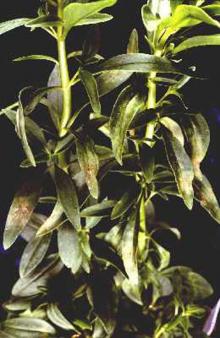Cause The fungus-like organism Peronospora antirrhini causes a systemic infection of young snapdragons. The disease is favored by cool, wet conditions and/or high humidity. Spores are produced between 44°F and 72°F, though 50°F is optimum. Sporangia are spread by wind, air currents, or splashing water. When they land on a healthy plant they germinate by means of a germ tube. Conditions that keep leaves wet for 6 to 10 hours favors this disease. The latent period can be as short as 4 days. Oospores are produced in abundance in infected tissue. Seed transmission may occur but has not been proved.
The cultivars Potomac Rose, Potomac Apple, and Potomac Dark Orange are less susceptible than cultivars Rocket White, Potomac Ivory, and Potomac Royal.
Symptoms Leaves curl in and droop down on seedlings. Affected plants are stunted and pale yellowish green. Dark-color cultivars develop purple spots; light-color cultivars develop yellow spots. Leaves' undersides may develop a white to purplish fungal growth (conidia and conidiophores). Stems and upper leaf surfaces can also show this symptom on young succulent plants. Severely infected plants are stunted, wilt, and eventually die. Larger plants can also be stunted, have pale-green leaves, lack flowering, and may have rosetting of the growing points. The growing point usually dies, and the plant often breaks off at the base, and then produces many secondary shoots from the base.
Cultural control The best management strategy is to integrate as many tactics as practical and economical as possible.
- Reduce greenhouse humidity by a combination of heating, venting, and moving air. Space plants for good air circulation.
- Scout plants carefully for symptoms of the disease especially the undersides of leaves and any stock plants or plants held over from the previous year.
- Avoid overhead irrigation or any practice that keeps plants wet for extended periods of time.
- Remove and destroy infected plants and plant debris.
- Plant resistant cultivars.
- Maintain adequate fertility.
Chemical control Use before symptoms develop. Rotate fungicides that have a different mode of action for resistance management. Limit the use of any one group during the growing season.
- Affirm WDG at 0.25 to 0.5 lb/100 gal water. Group 19 fungicide. 4-hr reentry.
- Compass 50 WDG at 1 to 2 oz/100 gal water plus a spreader-sticker. Do not use organosilicate additives. Group 11 fungicide. 12-hr reentry.
- CuPRO 5000 at 1.5 to 2 lb/A. Group M1 fungicide. 48-hr reentry.
- Disarm 480 SC at 1 to 4 fl oz/100 gal water. Group 11 fungicide. 12-hr reentry.
- Fenstop at 7 fl oz/100 gal water. For greenhouse use only. Group 11 fungicide. 12-hr reentry.
- Fosphite at 1 to 2 quarts/100 gal water. Do not use copper products within 20 days of treatment and do not use spray adjuvants. Group P7 fungicide. 4-hr reentry.
- Insignia SC at 3 to 6 fl oz/100 gal water. Do not use with organosilicate-based adjuvants. Use preventively only. Group 11 fungicide. 12-hr reentry.
- Mancozeb-based products can be used as mixing partners and provide some protection. Group M3 fungicides. 24-hr reentry.
- Fore 80 WP at 1.5 lb/100 gal water plus a spreader-sticker.
- Protect DF at 1 to 2 lb/100 gal. Variable results with different spreader-stickers.
- Micora at 4 to 8 fl oz/100 gal water. Group 40 fungicide. 4-hr reentry.
- Monterey Garden Phos at 0.5 to 1.1 fl oz/gal water as a foliar spray. Also labeled for soil drench, see label for details. Group P7 fungicide. H
- Orvego at 11 to 14 fl oz/100 gal water. Group 40 and 45 fungicide. Has not been effective. 12-hr reentry.
- Phyton 27 at 1.3 to 2.5 oz/10 gal water. Group M1 fungicide. 48-hr reentry.
- Segovis at 0.6 to 3.2 fl oz/100 gal water plus another fungicide. Group 49 fungicide. 4-hr reentry.
- Stature SC at 6.12 to 12.25 fl oz/100 gal water. Do not make more than 2 (two) sequential applications. Group 40 fungicide. 12-hr reentry.
- Subdue MAXX at 0.13 to 0.25 fl oz/100 gal water as a seeding drench or at 0.5 to 1 fl oz/100 gal water plus another fungicide as a foliar spray. Group 4 fungicide. 48-hr reentry.
- Zonix at 45 to 76 fl oz/100 gal water. Can be sprayed on crop or injected into irrigation system. Short residual so may have to be used frequently for adequate results. 4-hr reentry.
Note: Products that contain the group 11 fungicide azoxystrobin, such as Heritage and Mural, should be avoided due to phytotoxicity. Injury of certain cultivars may occur with repeated use.
Biological control
- Cease or Rhapsody (Bacillus subtilis strain QST 713) at 2 to 8 quarts/100 gal water. Active ingredient is a small protein. Efficacy in the Pacific Northwest is unknown. 4-hr reentry. O
References Byrne, J.M., Hausbeck, M.K. and Sconyers, L.E. 2005. Influence of environment on atmospheric concentrations of Peronospora antirrhini sporangia in field-grown snapdragon. Plant Disease 89:1060-1066.
Wegulo, S.N., and Chase, A.R. 2017. Diseases of Snapdragon. In McGovern, R.J., and Elmer, W.H. (eds.) Handbook of Florists' Crops Diseases. Springer Int.

